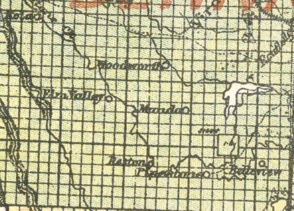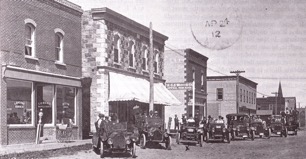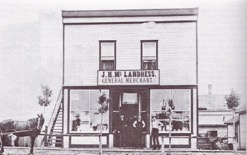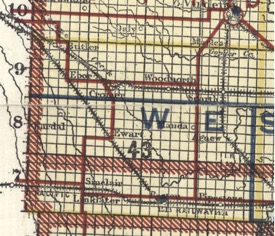Introduction
Overview
We have attempted to relate these site to the history of the region
through a series of short articles on:
1. Historic Claims of the area
2. Analysis Critera - Where
sites fit
in terms of the Community
Heritage
3. Community Layout
4. Notable People (See the Notable
People Project)
The project is intended as a "Beginning" rather than a Finished
Product.
Local groups and individuals are invited to amend and add to it. New
information is always welcome and we will make every effort to add
anthing that is sent to us.
One goal is to collect as much information about our older
buildings as we can. This will be found in the Sites section, and we
would appreciate corrections, additions, comments and questions as we
complete the project.
Community Historical
Claims
By the end of the settlement era three sets of
railway tracks crossed the Municipality of Pipestone. In 1892, the
C.P.R. line had been extended from Souris into the northern part of the
R.M. and would eventually create the towns of Pipestone, Reston and
Sinclair. In 1907 a branch of the C.N.R. cut across and the southern
reaches putting Scarth, Woodnorth, Cromer and Butler on the map.
Shortly thereafter, the C.P.R. created the Reston-Wolseley line giving
birth to Ewart and Ebor. By 1908, farmers throughout the municipality
had reliable connections with the rest of the province allowing much
easier marketing of their produce and much improved access to
agricultural equipment and consumer goods.
While the first towns may not have appeared until after 1890, the
region itself already had a long and interesting history. The wooded
valley of the Pipestone had long been a place of shelter, a gathering
place for various aboriginal peoples and a buffalo hunting
ground.
In 1881 the arrival of the transcontinental railway, first at Brandon,
then quickly extended to Oak Lake and Virden, allowed settlers easier
access to this territory.
The first settlers in the Pipestone Valley were Dan McKinnon and
A. McLean who arrived on May 28th, 1881. They were followed within days
by William and James Lothian.
Some of these first settlers came with the hope that a rail line would
soon cross the district. In the meantime the people of Pipestone had to
make long trips for supplies and to market their produce. That didn’t
stop them from establishing farms schools and churches, raising
families and generally getting on with life.
For the first ten years after farming operations commenced, the
scattered rural nature of settlement in the area was characterized by
various small rural centres: often just a post office, usually in a
farm home; and perhaps a school which might double as a church and
community hall. Lanark School and nearby Reston Post Office, which was
located on the Bullock farm, was one such community, often in those
days just referred to as, “The Settlement”. Elm Valley School and
Post Office in the Cromer Area was another centre to the west. Manda
and Woodnorth Post Offices were central and Belleview was on the
eastern edge of the district.
 This
map was created prior to 1890. The locations identified as “Reston” and
“Pipestone” refer to Post office locations as the railway (and the
villages) had not yet arrived.
This
map was created prior to 1890. The locations identified as “Reston” and
“Pipestone” refer to Post office locations as the railway (and the
villages) had not yet arrived.
Across Manitoba the arrival rail lines triggered the creation of
villages, typically centred around a railway station, elevator(s) and a
cluster of services. Schools and post offices were then generally moved
to new locations in the village.
The establishment in 1892 of the towns of Pipestone and Reston in the
midst of well-populated and productive farmland led to an initial burst
of commercial enterprises. The usual banks, general stores, drug and
jewellery stores appeared. Some of these would naturally be housed in
quickly erected frame buildings, but soon a few noteworthy buildings
such as the stone G.S. Monroe Store, the brick Berry House and the
Berry Block in Reston; and the frame Pipestone Presbyterian
Church in the village of Pipestone, were erected, all of which remain.
Several commercial buildings from the beginning of the 20th century
created a downtown streetscape in Reston, the general outline of which
does still exist today. Many fine homes also remain from that era.

Reston
in 1912.
Photo
from “Trails Along the Pipestone”
In most Manitoba communities, the “Establishment” era is defined by the
replacement of “Pioneer” log, sod and rough lumber buildings by more
ambitious constructions of milled lumber. With that definition in mind
the towns in the municipality of Pipestone can be said to have almost
skipped the Pioneer stage and proceeded directly to Establishment.
The rural areas of course did go through these phases. The
Consolidation period can be said to have started in the early 1900’s
with the erection of the several “downtown” brick blocks in Reston, the
Arlington Hotel in Pipestone, and retail expansion in general.
In the early years of the twentieth century Reston consolidated its
position as the primary trading centre for the region while Pipestone,
though a vibrant community, offered more limited commercial services.

Sinclair,
Manitoba, ca. 1910
Photo from
“Trail Along the Pipestone”
Sinclair was created a little later and also offered a modest, though
vital, range of services. The villages created later along the
subsequent branch lines were always quite small but served their role.
Rinks and community halls, elevators and general stores gave a physical
presence to the even stronger underlying reality – the sense of
community.
 This
map from 1918 shows the changed brought by the railway.
This
map from 1918 shows the changed brought by the railway.
As the R.M. of Pipestone looks forward to the next century it has taken
steps to preserve important aspects of its past, including the creation
of the Reston Museum, the designation of several buildings, most
notably, the attractive Pipestone Municipal Office in Reston and a rare
C.P.R. Engine House.
Analysis Criteria
Aboriginal Peoples
The Canupawakpa Sioux reserved was established in the 1870’s with the
final (and present) location settled in 1877. Sioux had been occasional
visitors to this part of Manitoba for nearly two centuries, generally
in conflict with local Assiniboines. Several small groups looked to
Canada as a refuge after the most notable historic clashes with the
U.S. Army in 1862 and 1876.
Settlers and Defining Culture
By 1881 a trickle of settlers, largely from Ontario approached the
district from the north having taken river the new C.P.R. line west
from Winnipeg as far as it went and using oxen to haul their good the
rest of the way. The beginning of regular railway service to
Brandon brought many more in the spring of 1882, also mainly from
Ontario. The area was well settled by the time the railway arrived in
1890.
Other Settlement/Ethnic Groups
Beginning in 1892 a number of settlers of Icelandic origin settled in
the Sinclair region, many of these came from the R.M. of Argyle, about
100 km to the east, where a large Icelandic settlement, started in
1881, was perhaps short of homestead options by this time.
Economic Engines
Farming formed the economic basis of virtually all prairie settlements
but many communities sought to enhance the agriculture by encouraging
some local “value added” processing. In Pipestone, where settlement
preceded the arrival of a rail link by a decade, the relative proximity
to the main C.P.R. likely rendered local grist and lumber mills
unnecessary.
Commercial Growth
The towns of Pipestone and Reston, typical of the “Railway” towns of
the era, saw an initial burst of commercial enterprises; banks, general
stores, farm supply dealers, drug and jewelry stores, which appeared to
supply eager consumers who had been settled in the region for years.
They were the first towns in the region and they remain the dominant
commercial centres today. The creation of two branch lines in the early
1900’s extended services into all parts of the municipality and created
smaller regional villages that fulfilled an important economic and
social role. Scarth, Woodnorth, Cromer and Butler were established on
the C.N. line that crossed the northern part of the municipality from
east to west. Ewart and Ebor were on the Reston-Wolesley C.P. Branch
that angled north-west from Reston. The commercial utility of these
centres faded as the improved mobility of consumers, the
“rationalization” of rail lines and grain delivery, and the changing
nature of farming each had its impact. Their social/cultural role as
centres of community activities is still evident. Of these villages,
Cromer retains some commercial services today while Woodnorth retains
some of its village character. In the remainder a cairn, a well-tended
graveyard, and a few scattered buildings tell the story.
The exploitation of regional oil reserves has created a renewed
economic activity in the area, the full results of which are yet to be
seen.
Social & Cultural Development
The settlement of the region began in earnest with the arrival of Dan
McKinnon, A. McLean and the Lothian brothers in 1881.
For the first ten years after farming operations commenced, communities
were identified by their post office or school. The towns of Pipestone
and Reston were quickly established, with the arrival of the first rail
line in 1891 and service was improved with additional lines in the
early 1900’s and the creation of the villages along those new lines.
The re-alignment of communities around the new villages changed the
dynamics of commercial, social, and spiritual life for the citizens of
Pipestone. Religious services that had taken place in homes and schools
were moved to the newly erected Churches. Grain and livestock need only
be taken as far as the railway station. Shopping for consumer goods and
agricultural supplies was done in local outlets. Dances, performances
and all manners of entertainment and cultural activities moved to
community halls. All these things and more made the village the
community focal point.
Community Form and Layout
Reston
The layout of the village of Reston, as with the other villages in
Pipestone, was a direct response to the railway line to which it owes
its existence. Like many prairie communities, it grew primarily on one
(north) side of the tracks.
The railway runs west-east and the town was surveyed to conform. First
Avenue runs parallel to the track and of the grid of side streets
running northwards, Fourth Street evolved as the primary business
street.
That Reston grew quickly and confidently is not surprising in that the
community with its agricultural base well developed by the time the
rail line arrived. There was very little speculation or uncertainty
about its potential importance as a service centre and very little
fanfare and boosting. It was as if it knew exactly what it was going to
be. The building that followed the arrival of the rail line established
both the limits and pattern of a layout which has remained relatively
unchanged.
Pipestone
Pipestone was the first town established in the municipality as the
railway approached westward from Souris. Housing and basic businesses
sprang up on the north side of the tracks, with some services along
First Avenue, parallel to the tracks (east-west) and the main retail
outlets on a side street (Fourth Street). Its form and layout is
retained today.
Other Villages
The small villages of Woodnorth, Cromer, Sincalir and Ebor each feature
a modest grid of streets in a layout still evident today. Scarth,
Butler and Ewart were even less urban in concept and appearance.
|

